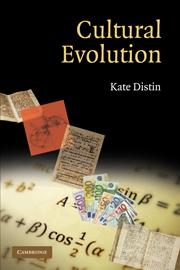Book contents
- Frontmatter
- Contents
- Cultural Evolution
- 1 Introduction
- PART I THE INHERITANCE OF CULTURAL INFORMATION
- PART II THE INHERITANCE OF CULTURAL INFORMATION
- 4 Natural Language and Culture
- 5 How Did Natural Language Evolve?
- 6 Language, Thought and Culture
- PART III THE INHERITANCE OF CULTURAL INFORMATION
- PART IV THE RECEIVERS OF CULTURAL INFORMATION
- PART V THE EXPRESSION OF CULTURAL INFORMATION
- 14 Conclusion
- Appendix
- Acknowledgements
- Bibliography
- Index
5 - How Did Natural Language Evolve?
Published online by Cambridge University Press: 05 June 2012
- Frontmatter
- Contents
- Cultural Evolution
- 1 Introduction
- PART I THE INHERITANCE OF CULTURAL INFORMATION
- PART II THE INHERITANCE OF CULTURAL INFORMATION
- 4 Natural Language and Culture
- 5 How Did Natural Language Evolve?
- 6 Language, Thought and Culture
- PART III THE INHERITANCE OF CULTURAL INFORMATION
- PART IV THE RECEIVERS OF CULTURAL INFORMATION
- PART V THE EXPRESSION OF CULTURAL INFORMATION
- 14 Conclusion
- Appendix
- Acknowledgements
- Bibliography
- Index
Summary
If cultural evolution is a separate process from biological evolution then it must be the product of a separate inheritance mechanism. I have shown that inheritance in any realm is dependent on generations of receivers that can detect and react to variations in that which is inherited. This means that cultural evolution can happen only in species whose members can detect and react to cultural variations. The previous chapter outlined how the human species was preadapted, or in other words biologically prepared, for culture. In particular, our tendencies to live in large social groups, to share information with one another, and to notice and imitate social conventions are all key factors in cultural evolution. But it was not until natural language became widespread among our ancestors that cultural information had a mechanism for inheritance. The emergence of a shared natural language created generation after generation of receivers for the cultural information that the language carried. What cultural evolutionary theory needs, then, is a Darwinian account of the evolution of natural language in our preadapted species.
Against the background of a range of cognitive, social and physiological preadaptations such as those addressed in the previous chapter, it is not hard to understand why an emerging capacity for precise and complex communication would have enabled us not only to survive in a broader range of environments but also to live in larger and more complex social groups.
- Type
- Chapter
- Information
- Cultural Evolution , pp. 62 - 77Publisher: Cambridge University PressPrint publication year: 2010



